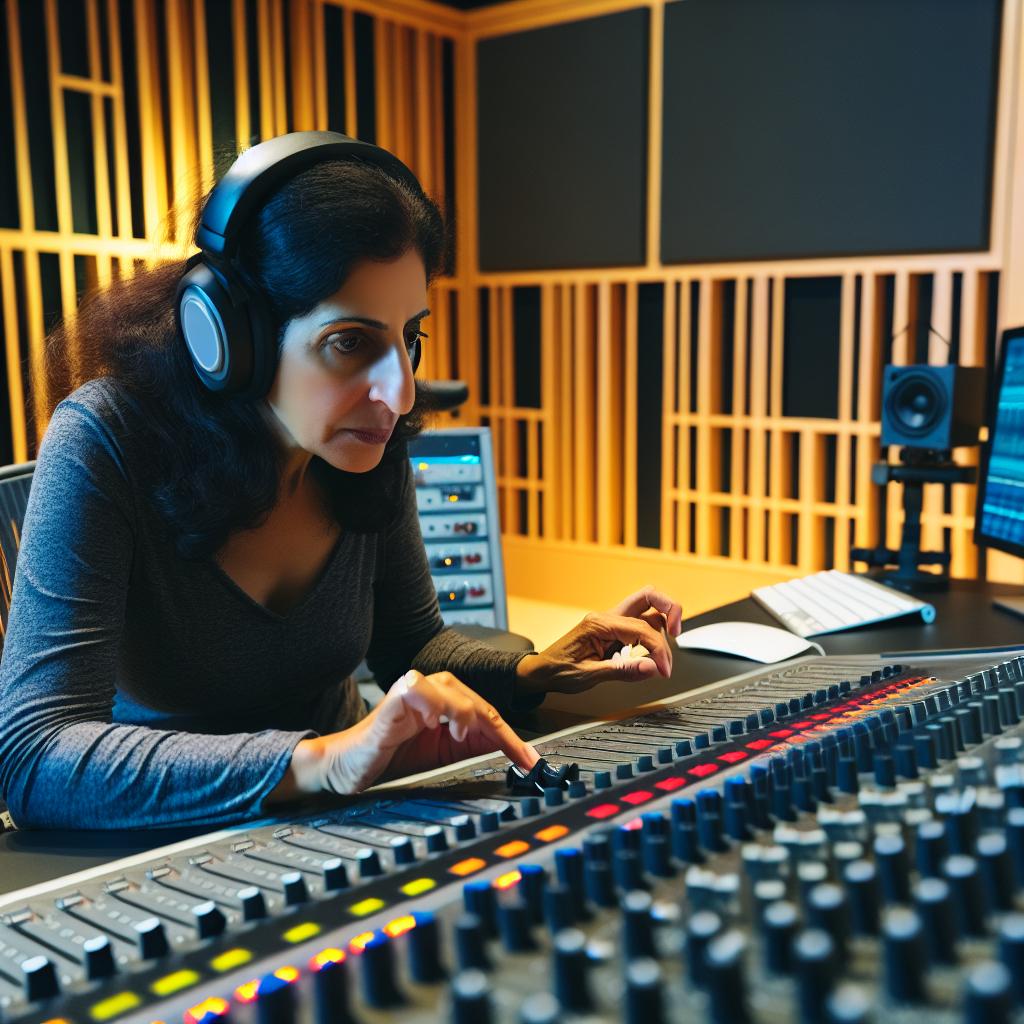Introduction
A sound designer creates and manipulates audio for various media.
They work in film, television, theater, and video games.
Their job involves recording dialogue, creating sound effects, and designing soundscapes.
Sound design enhances the viewer’s experience.
It immerses audiences in a story, conveying emotions and building atmosphere.
Essential elements like background sounds, music, and sound effects also improve narrative depth.
Importance of Sound Design Across Industries
In film, sound designers create aural textures that complement visuals.
They help convey moods and themes effectively.
A well-designed soundscape can leave a lasting impression on viewers.
In video games, sound design plays a crucial role in gameplay immersion.
Designers create sounds that respond dynamically to player actions.
This interaction engages players and amplifies their experience.
Theater productions rely on sound designers to enhance live performances.
They craft audio that supports voice clarity and complements stage dynamics.
Sound helps bridge the emotional connection between the actors and the audience.
Furthermore, sound design impacts the advertising industry.
Commercials often use catchy jingles and sound effects to capture attention.
Effective audio can drive brand recognition and influence consumer behavior.
In all these fields, sound designers collaborate with directors, producers, and other creatives.
This collaboration ensures that audio aligns with visual elements and enhances storytelling.
Transform Your Career Today
Unlock a personalized career strategy that drives real results. Get tailored advice and a roadmap designed just for you.
Start NowA sound designer’s work contributes significantly to the overall production quality.
As industries increasingly recognize sound design’s value, demand for skilled professionals rises.
This growth leads to a variety of opportunities for aspiring sound designers.
Understanding the salary expectations in this field becomes crucial for career planning.
Average Salary Range for Sound Designers
The average salary range for sound designers typically falls between $40,000 and $100,000 annually.
This range depends on various elements such as experience, location, and the specific industry.
- Entry-Level Positions: New sound designers usually earn between $40,000 and $55,000. These roles often include assisting senior sound designers and working on smaller projects.
- Mid-Level Positions: With three to five years of experience, sound designers can expect salaries between $55,000 and $75,000. At this level, they often lead projects and collaborate closely with directors.
- Senior-Level Positions: Experienced sound designers with over five years can earn from $75,000 to $100,000. They typically manage teams and oversee significant productions.
Factors Influencing Salary
Multiple factors influence a sound designer’s salary.
Understanding these can help you gauge potential earnings in this career.
- Experience: More experience usually translates to higher salaries. Senior sound designers command more money due to their expertise.
- Location: Salaries can vary by geographic area. Urban centers with thriving entertainment industries usually offer higher pay.
- Industry: Different industries pay differently. Television usually offers lower salaries, while video games might offer more.
- Company Size: Larger, established companies often pay more than small independent firms.
- Project Type: Feature films and AAA video games typically pay more than short films and indie games.
Salary Based on Location
Location significantly impacts the salary of sound designers.
Different cities and regions have varying demand for sound design talent.
Here are some average salary figures based on location:
- Los Angeles: $60,000 to $120,000
- New York City: $55,000 to $115,000
- San Francisco: $70,000 to $130,000
- Austin: $50,000 to $90,000
- Atlanta: $45,000 to $80,000
Comparison to Other Similar Professions in the Entertainment Industry
When comparing sound designers to other professions in the entertainment industry, it’s helpful to see how salaries stack up.
Several related fields include sound engineering, music production, and audio post-production.
- Sound Engineer: Salaries typically range from $40,000 to $90,000. They focus more on the technical aspects of sound.
- Music Producer: Artists and producers earn between $50,000 and $150,000. This position blends artistic and technical skills.
- Audio Post-Production Specialist: These specialists earn between $45,000 and $95,000. They work closely with sound design to finish projects.
- Score Composer: Composers can earn $40,000 to $150,000, depending on experience and project scale.
- Sound Mixer: Mixers generally earn between $50,000 and $100,000. They focus on balancing audio elements in productions.
Understanding Career Prospects in Sound Design
A sound designer’s salary varies greatly based on experience, location, industry, and individual skills.
Understanding the nuances helps aspiring sound designers know what to expect.
The demand for skilled sound designers remains strong as the entertainment industry continues to evolve.
This trend can result in lucrative opportunities and satisfying careers.
Pursuing a career in sound design can be rewarding.
It combines creativity, technology, and a passion for storytelling.
Showcase Your Business Today
Reach thousands of readers actively exploring professional services. Publish your business profile and grow your audience now.
Publish NowTaking these factors into account can help you navigate your career path effectively.
Understanding sound designer salaries requires examining several influencing factors.
Each component plays a crucial role in determining how much sound designers can expect to earn.
Below, we explore these factors in detail.
Education and Training
One of the primary factors that influence a sound designer’s salary is their level of education and training.
The more experienced and educated a sound designer is, the higher their salary can be.
Here are some common educational paths:
- Bachelor’s Degree: Many sound designers hold a bachelor’s degree in fields like audio engineering or music production. Graduates usually start their careers at a lower salary level.
- Master’s Degree: A master’s degree can provide an edge. It often leads to advanced positions and higher pay.
- Certification Programs: Various institutions offer specialized programs in sound design. These programs can enhance skills quickly and improve employability.
- Workshops and Internships: Hands-on experience gained through workshops or internships can be invaluable. This experience helps aspiring sound designers develop their skills in real-world settings.
Advanced education often opens doors for higher salaries.
However, practical experience can sometimes offset lower formal education levels.
Many employers value experience highly, particularly in creative industries.
Type of Industry
The industry in which a sound designer works significantly impacts their salary.
Different sectors offer varied payment scales.
Here’s a breakdown of how different industries stack up:
- Film Industry: Sound designers in film typically earn high salaries. Low-budget films, however, may offer less.
- Video Gaming: This rapidly growing industry provides lucrative opportunities for sound designers. Successful titles often have sizable budgets, leading to higher salaries.
- Music Production: Salaries vary significantly. Established professionals may command high fees, while those starting out can earn less.
- Advertising: Sound designers for commercials often receive competitive pay. Their contributions can be crucial for effective campaigns.
- TV and Radio: Opportunities exist in broadcast media. Salaries may be lower than film but can still be competitive.
Different industries value sound design differently.
For instance, video game companies often invest more in audio due to the immersive experience required.
Thus, sound designers can earn more in this field.
Company Size and Budget
The size and budget of the company where a sound designer works also influence salary.
Larger companies often have more resources to allocate for salaries.
Here are some considerations:
- Large Corporations: Big companies, especially in the film or gaming sectors, usually pay better. They offer comprehensive benefits and bonuses as well.
- Small Companies: Smaller firms may have limited budgets. While salaries might be lower initially, there may be more opportunities for creative freedom.
- Freelance Opportunities: Freelancers can set their rates. However, income is variable, depending on client and project.
- Startups: Startups may offer equity or profit-sharing. Such compensation can drive potential future earnings higher.
Company budget can dictate salary levels too.
A substantial budget typically signals higher potential earnings for sound designers.
However, even small companies can be rewarding, especially in creative environments.
Experience Level
Experience level profoundly affects sound designer salaries.
More experienced designers command higher pay compared to their entry-level counterparts.
Here’s how experience influences earnings:
- Entry-Level Positions: New sound designers generally start at lower salaries. This phase involves gaining practical experience.
- Mid-Level Positions: After a few years, salaries typically increase. Experience in specific areas of sound design can lead to promotions.
- Senior-Level Positions: Senior sound designers enjoy the highest salaries. Their expertise plays a significant role in project success.
- Specialized Skills: Designers with niche skills can command premium rates. Expertise in areas like Foley or music composition can differentiate them.
Experience builds reputation and credibility.
This reputation can translate into better job opportunities and salary negotiations.
Location
Where a sound designer works heavily impacts their salary.
Geographic location determines cost of living and demand.
Here’s how:
- Urban Areas: Cities with thriving entertainment industries can offer higher salaries. Places like Los Angeles or New York are prime examples.
- Cost of Living: Salaries must accommodate local living expenses. Higher costs can lead to higher salary offers.
- Regional Demand: Specific regions might be in higher demand for sound designers. A competitive job market can drive salaries up.
- Remote Opportunities: With technology, remote work is increasingly common. This flexibility can allow sound designers to work for high-paying companies in low-cost areas.
Location can create significant salary disparities.
Sound designers should consider moving to higher-demand areas for better financial opportunities.
Factors Affecting Sound Designer Salaries
Many interrelated forces affect sound designer salaries.
Education, industry, company size, experience, and location all play critical roles.
Each factor contributes to the overall compensation package a sound designer can expect.
Aspiring sound designers should consider these elements carefully as they plan their careers.
Navigating these factors wisely can lead to fulfilling and lucrative careers in sound design.
See Related Content: Future of Media Research Analyst Roles in AI Era
Sound design is a vibrant and dynamic field that comes with a myriad of benefits and perks.
These advantages not only enhance job satisfaction but also contribute to a fulfilling career.
Showcase Your Business Today
Reach thousands of readers actively exploring professional services. Publish your business profile and grow your audience now.
Publish NowIn this section, we will explore some key benefits of being a sound designer, including flexible work hours, opportunities for freelance and remote work, and the potential for career growth and development.
Flexible Work Hours
One of the most attractive perks of being a sound designer is the flexibility in work hours.
Many sound designers enjoy a considerable amount of autonomy in their schedules.
Here are some highlights:
- Choice of Working Hours: Sound designers can often choose when to work. This allows for better alignment with personal rhythms and productivity peaks.
- Avoiding Rush Hour: With flexible hours, sound designers can avoid peak traffic times. This leads to less stress and more energy upon arriving at work.
- Balance Personal Life: Flexibility makes it easier to manage personal commitments, such as family and hobbies. Sound designers can harmonize work and life more effectively.
- Meeting Client Needs: Sound designers can adapt their schedules to fit client needs. This level of customization can lead to stronger client relationships and satisfaction.
- Project-Based Work: This field often revolves around projects, allowing designers to plan their work schedules around these timelines. They can allocate time efficiently to meet deadlines.
Opportunities for Freelance and Remote Work
The world of sound design offers abundant opportunities for freelancing and remote work.
This flexibility is particularly appealing for creative professionals who seek independence.
Below are the primary benefits of this aspect:
- Work From Anywhere: Technology has made remote work a viable option. Sound designers can create soundscapes from the comfort of their homes or while traveling.
- Diverse Clients: Freelance sound designers can work with various clients across industries. This variety keeps the work interesting and expands professional networks.
- Set Your Rates: Freelancers have the freedom to set their own rates for projects. This can lead to earning potential that matches their skills and expertise.
- Control Over Projects: Freelancing allows designers to choose projects that excite them. This leads to a more enjoyable work experience and personal growth.
- Building a Portfolio: Freelancers can accumulate diverse projects that enhance their portfolio. A strong portfolio can attract better clients and more substantial projects.
Possibility for Career Growth and Development
Sound design is not just a job; it is a career with ample opportunities for growth and development.
As sound designers hone their skills, they can unlock numerous paths.
Here are some avenues for career advancement:
- Expanding Skill Sets: Sound design encompasses various areas, including music composition, sound editing, and sound effects creation. Learning these skills can open doors to new opportunities.
- Networking Opportunities: The sound design community is vibrant and collaborative. Engaging with other professionals can lead to new projects and career paths.
- Specialization Options: Designers have the option to specialize in fields like film, gaming, or theater. Specialization can lead to higher demand and better compensation.
- Workshops and Conferences: Many organizations host workshops, conferences, and training programs. Participating in these events can enhance knowledge and foster networking connections.
- Mentorship Opportunities: Aspiring sound designers can seek guidance from seasoned professionals. Mentorship relationships can provide insights and career advice.
- Access to Cutting-Edge Technology: Sound designers in firms often work with the latest technology. Staying updated ensures they remain competitive in this evolving field.
The benefits and perks of being a sound designer extend far beyond simple job satisfaction.
The ability to work flexible hours allows for a better work-life balance, making this career appealing for many.
Additionally, the opportunities for freelancing and remote work provide freedom that enhances creativity and innovation.
Finally, sound designers can pursue a variety of paths for career growth and development, ensuring that their journey is both fulfilling and exciting.
Those entering this profession can expect a rich and rewarding experience filled with opportunities to thrive in a creative industry.
You Might Also Like: The Importance of Media Planner Internships
Sound Design: A Creative and Technical Journey
Sound design is an exhilarating career path that combines creativity and technology.
However, it is not without its challenges.
Understanding these challenges can better prepare aspiring sound designers.
This section will explore the competitive job market, long hours, tight deadlines, and limited job opportunities in certain regions.
Competitive Job Market
The sound design industry is highly competitive.
Many talented individuals pursue positions in this field.
As a result, standing out becomes essential.
Here are several factors contributing to the competitive nature of this job market:
- Talent Pool: With advances in technology, more individuals can create sound designs. Accessible tools have flooded the market with aspiring sound designers.
- Educational Background: Many applicants hold degrees in sound design or related fields. A relevant degree often becomes a prerequisite for many jobs.
- Experience Matters: Employers often prefer candidates with previous experience. Internships or entry-level roles become essential for career growth.
- Networking is Crucial: Personal connections often lead to job opportunities. Attending industry events can facilitate connections and recommendations.
- Specialization: Some candidates specialize in specific areas. Types of sound design may include film, gaming, or theater. Employers often seek expertise aligned with their project needs.
Because of this competitive landscape, many aspiring sound designers must put in extra effort.
They need to refine their skills continually.
They should seek opportunities to collaborate with others.
Building a strong portfolio becomes vital for showcasing their abilities.
Long Hours and Tight Deadlines
Another significant challenge in sound design is the demanding work schedule.
Many projects require long hours and can create high-pressure environments.
Here’s a closer look at this aspect:
- Project Demands: Each project brings its own set of challenges. Designers often need to adapt quickly to the evolving needs of a production.
- Creative Process: Sound design requires an extensive creative process. Designers may spend countless hours brainstorming and experimenting with sound elements.
- Revisions: Project stakeholders often request changes or revisions. Designers might work late into the night making adjustments based on feedback.
- Deadlines: Many projects operate under tight deadlines. This urgency can lead to increased stress, affecting the quality of work.
- Work-Life Balance: Long hours can disrupt personal lives. Balancing work commitments and personal time becomes increasingly challenging.
While the adrenaline rush of impending deadlines may invigorate some, for others, it can lead to burnout.
Sound designers may need to develop effective time management strategies.
This may involve setting realistic goals.
They should also practice open communication with team members.
Appropriate workload distribution can alleviate some pressure.
Limited Job Opportunities in Certain Regions
Geographical location significantly impacts job availability in sound design.
Some regions have a booming entertainment industry, while others have limited options.
Understanding regional dynamics is essential.
Here are key points to consider:
Showcase Your Business Today
Reach thousands of readers actively exploring professional services. Publish your business profile and grow your audience now.
Publish Now- Urban vs. Rural: Major cities often provide more opportunities. Places like Los Angeles or New York are known industry hubs.
- Industry Growth: Regions with a thriving film or gaming industry tend to offer more job opportunities. Candidates in these areas have better chances of finding positions.
- Remote Work: The rise of technology allows for remote work in some cases. However, not all positions offer this flexibility.
- Networking Opportunities: Regions with a strong community offer more chances for networking. This can directly affect job prospects in those areas.
- Cost of Living: Being in a major city may come with a higher cost of living. Designers must determine if job salaries offset these expenses.
To cope with limited opportunities, aspiring sound designers should consider relocation.
Moving to a more viable area can enhance career prospects.
Additionally, remote work opportunities should be explored.
This approach opens up more possibilities, regardless of location.
Despite these challenges, many sound designers find immense satisfaction in their work.
They create stunning auditory landscapes that enhance visual experiences.
By understanding these obstacles, aspiring professionals can strategically navigate their way through them.
A successful career in sound design is attainable with the right mindset and preparation.
Delve into the Subject: Crafting Clear and Concise Crisis Communication Messages

Increasing Your Earning Potential as a Sound Designer
As a sound designer, your earning potential can be influenced by several factors.
It’s essential to take proactive steps to enhance your income.
Below are key strategies to increase your earning potential in this competitive field.
Continuing Education and Certifications
Investing in education and certifications can significantly enhance your skills.
Staying updated with industry trends keeps you competitive.
Here are several paths to consider:
-
Attend Workshops and Seminars:
Participate in workshops focusing on new technologies.
These sessions often impart specialized skills that increase your marketability.
-
Pursue Relevant Degrees:
Consider earning degrees in sound design, audio engineering, or music production.
Advanced degrees can open doors to new opportunities.
-
Get Certified:
Obtain certifications from recognized organizations.
Certifications in software like Pro Tools or Logic Pro show your expertise and commitment.
-
Learn New Software:
Familiarity with cutting-edge tools can give you a competitive edge.
Mastering industry-standard software keeps your skills relevant.
-
Participate in Online Courses:
Enroll in online courses that focus on niche areas.
Websites like Coursera and Udemy offer valuable options.
Continuing education not only boosts your knowledge but also demonstrates your dedication to the craft.
Employers often favor candidates who actively seek growth.
Building a Strong Portfolio of Work
Your portfolio serves as your professional testament.
An impressive collection of your work can help attract higher-paying clients and projects.
Here’s how to create a standout portfolio:
-
Diversify Your Projects:
Showcase a range of work across different mediums.
Include film, video games, and installations to display versatility.
-
Highlight Your Best Work:
Choose only your most impressive projects.
Quality often trumps quantity in portfolio presentation.
-
Add Case Studies:
Include case studies to explain your thought process.
Detail your contribution to each project and the resulting impact.
-
Keep It Updated:
Regularly update your portfolio.
As you progress in your career, ensure that your portfolio reflects your latest achievements.
-
Create an Online Presence:
Build a website to host your portfolio.
A professional, easy-to-navigate site can attract more clients.
A strong portfolio not only showcases your skills but also communicates your unique style.
It acts as a vital marketing tool in your career.
Networking Within the Industry
Networking plays a critical role in advancing your career.
Connections can lead to job opportunities, collaborations, and valuable insights.
Discover several effective networking strategies:
-
Attend Industry Events:
Participate in sound design conferences and workshops.
They provide excellent opportunities to meet professionals and expand your network.
-
Join Professional Associations:
Become a member of organizations like the Audio Engineering Society (AES).
Membership often provides access to exclusive resources and events.
-
Utilize Social Media:
Engage with industry professionals on platforms like LinkedIn, Facebook, and Twitter.
Share your insights and connect with others regularly.
-
Collaborate with Other Creatives:
Work alongside filmmakers, musicians, or game developers.
Collaborations often lead to referrals and future projects.
-
Participate in Forums and Groups:
Join online forums specific to sound design.
Engage in discussions that can build rapport with peers in the industry.
By networking effectively, you not only increase visibility but also open doors to unexpected opportunities.
Building meaningful relationships can lead to referrals and collaborations that enhance your career.
Utilize Freelancing Opportunities
Freelancing can significantly bolster your earnings.
It allows you to take on projects that interest you and set your rates.
Consider these approaches to maximize your freelance income:
-
Specialize in a Niche:
Focus on a specific area, like game sound design or audio post-production.
Specialization can draw clients seeking your expertise.
-
Set Competitive Rates:
Research industry standards to determine your rates.
Ensure your pricing reflects your skills and experience.
-
Build Strong Client Relationships:
Develop rapport with clients through excellent service.
Happy clients are more likely to refer you and return for future projects.
-
Promote Your Services:
Use social media and professional platforms to advertise your services.
Consistently promote your work to attract new clients.
-
Leverage Freelancing Platforms:
Utilize platforms like Upwork or Fiverr.
They can help you find clients and establish your freelance business.
Freelancing provides flexibility and a chance to diversify your income sources.
By successfully managing multiple projects, you can significantly increase your overall earnings.
Increasing your earning potential as a sound designer requires strategic efforts.
By investing in your education, building a solid portfolio, networking, and exploring freelancing opportunities, you can significantly boost your income.
Each strategy contributes to your skills and marketability.
A proactive approach will lead to greater success and fulfillment in your sound design career.
Explore Further: Key Traits of an Effective Corporate Communications Trainer
Salary Expectations for Sound Designers
Salaries vary widely based on location, experience, and industry.
Entry-level positions generally start lower.
Seasoned professionals can earn significantly more.
Showcase Your Business Today
Reach thousands of readers actively exploring professional services. Publish your business profile and grow your audience now.
Publish NowDifferent industries, such as film, television, and gaming, offer distinct compensation ranges.
Understanding these factors helps you navigate your career in sound design.
As you’ve seen, specialization can also impact your earning potential.
Sound design for video games, for instance, often comes with higher pay due to its demand.
Freelancing offers flexibility but may result in fluctuating income.
For aspiring sound designers, stay motivated in your journey.
Yes, challenges will arise, but passion drives your creativity.
Learning continuously will enhance your skills and keep you competitive.
Networking also plays a crucial role in your growth.
The industry thrives on connections and partnerships.
Always remember to research your salary expectations.
Each job offer presents an opportunity to negotiate your worth.
Conduct thorough research into industry standards before discussions.
Understanding your value can significantly influence your final compensation.
Prioritize finding a position that aligns with your skills and goals.
Pursue your passion wholeheartedly.
Sound design can be both rewarding and challenging.
Stay committed, and you will thrive in this vibrant field.
Additional Resources
Garrett Tiedemann – Mix Engineer/Sound Designer/Production …
[E-Books for Sale]
The Big Book of 500 High-Paying Jobs in America: Unlock Your Earning Potential
$19.99 • 500 High-Paying Jobs • 330 pages
Explore 500 high-paying jobs in America and learn how to boost your career, earn more, and achieve success!
See All 500 High-Paying Jobs of this E-Book
1001 Professions Without a Degree: High-Paying American Jobs You Can Start Now
$19.99 • 1001 Professions Without a Degree • 174 pages
Discover 1001 high-paying jobs without a degree! Unlock career tips, skills, and success strategies for just $19.99!




